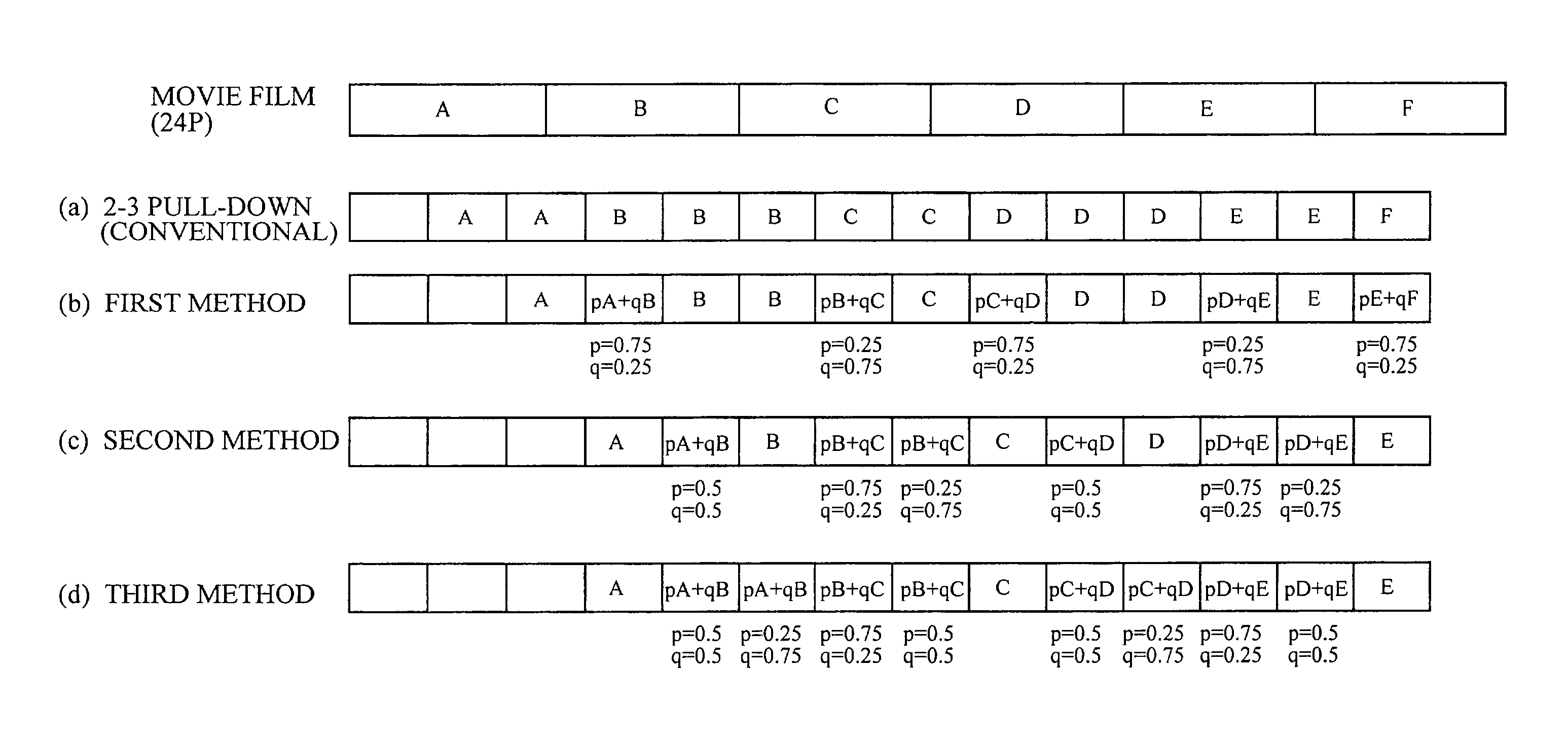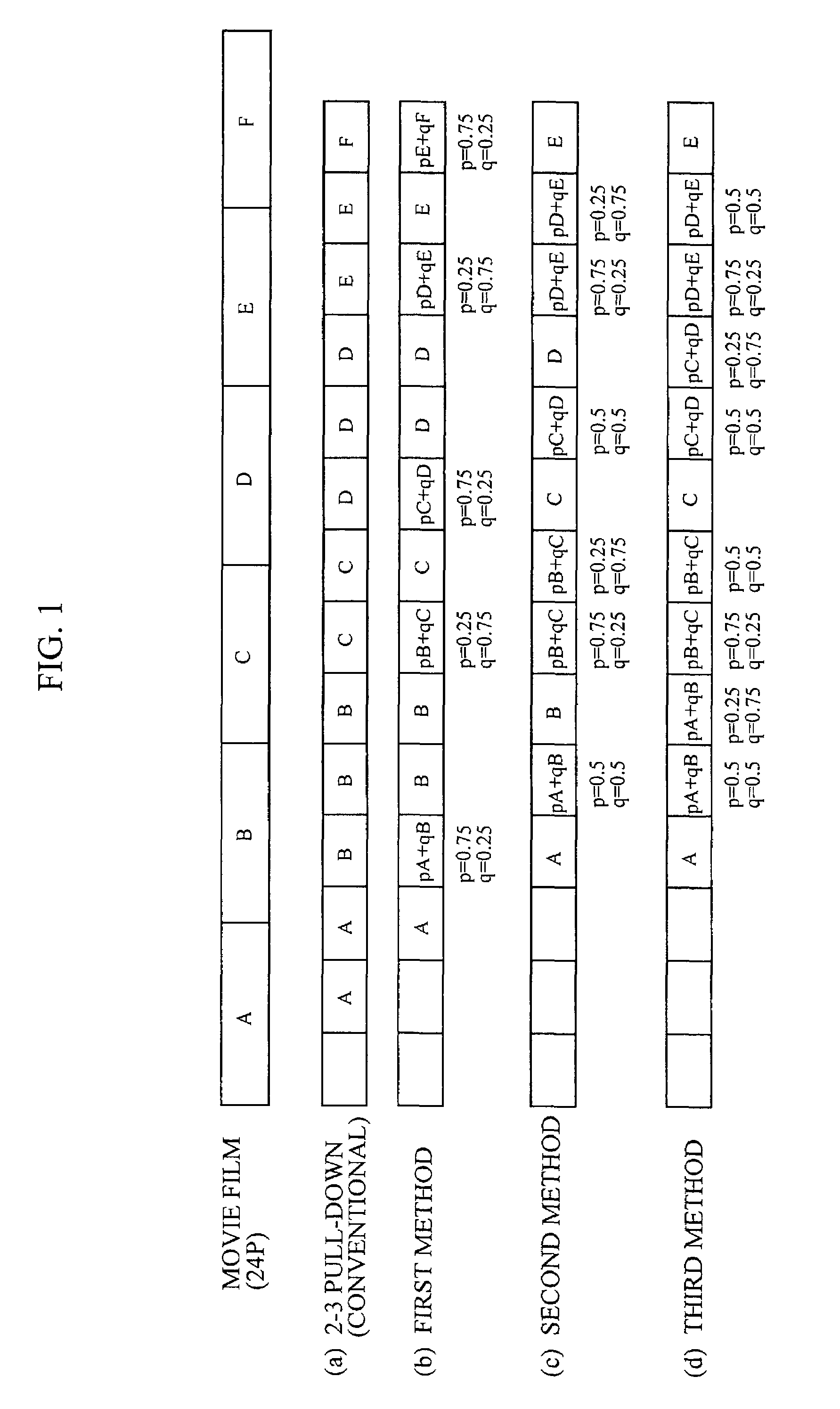Telecine converting method
a converting method and telecine technology, applied in the field of telecine converting methods, can solve the problems of incompatibility of video and significant incompatibility of feeling
- Summary
- Abstract
- Description
- Claims
- Application Information
AI Technical Summary
Benefits of technology
Problems solved by technology
Method used
Image
Examples
first embodiment
[A] Description of First Embodiment
[0040][1] Description of Telecine Converting Method Description is made of a telecine converting method for converting a movie film composed of 24 frames per second (24P) into a progressive video signal composed of 60 frames per second (60P) using linear interpolation in the whole of a screen.
[0041]FIGS. 1(b), 1(c), and 1(d) respectively illustrate three specific telecine converting methods using the linear interpolation in the whole screen.
[0042][1-1] Description of First Method Shown in FIG. 1(b)
[0043]The first method uses, in a portion where videos are switched, as in switching from a video A to a video B (a video before the switching is taken as Qn, and the subsequent video is taken as Qn+1) in a 2-3 pull-down system, not the subsequent video Qn+1 as it is but an interpolated video (pQn+qQn+1) obtained by interpolating the videos Qn and Qn+1 before and after the switching.
[0044]Interpolation factors p and q are determined such that the sum ther...
second embodiment
[B] Description of Second Embodiment
[1] Description of Telecine Converting Method
[0067]Description is made of a telecine converting method for converting a movie film composed of 24 frames per second (24P) into a progressive video signal composed of 60 frames per second (60P) using linear interpolation for each block in a screen.
[0068]In the second embodiment, telecine conversion is made by not the interpolation in the whole of the screen as in the first embodiment but finding interpolation factors for each block in the screen.
[0069]That is, the screen is divided into a plurality of blocks, to calculate for each of the blocks an interpolation factor on the basis of information related to the movement of a video in the block. In the present embodiment, the interpolation factors p and q for each pixel are calculated on the basis of the interpolation factor found for each of the blocks. An interpolated video is produced using the calculated interpolation factors p and q for each pixel....
third embodiment
[C] Description of Third Embodiment
[0117]According to the first or second embodiment, the movement of a video becomes smoother than that in the conventional 2-3 pull-down system. When the video after telecine conversion is displayed on a CRT (Cathode-Ray Tube), it has become clear that flicker, that is, a phenomenon that a video seems to be flickering by the variation in the luminance level occurs depending on the type of the video.
[0118]The reason why the flicker occurs is conceivably that interpolation factors p and q the sum of which is one are used, so that the luminance level varies between a video obtained by interpolation and a video which is not interpolated. This will be more specifically described.
[0119]As shown in FIG. 17, a moving object (an oblique portion) X having a high luminance shall exist between a frame video A and a frame video B. The frame video A and the second frame video B are interpolated using two interpolation factors p and q the sum of which is one, ther...
PUM
 Login to View More
Login to View More Abstract
Description
Claims
Application Information
 Login to View More
Login to View More - R&D
- Intellectual Property
- Life Sciences
- Materials
- Tech Scout
- Unparalleled Data Quality
- Higher Quality Content
- 60% Fewer Hallucinations
Browse by: Latest US Patents, China's latest patents, Technical Efficacy Thesaurus, Application Domain, Technology Topic, Popular Technical Reports.
© 2025 PatSnap. All rights reserved.Legal|Privacy policy|Modern Slavery Act Transparency Statement|Sitemap|About US| Contact US: help@patsnap.com



